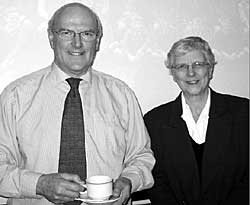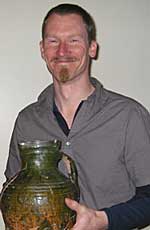Events and excursions, Spring 2009
THE MAURICE BARLEY LECTURE, 14 FEBRUARY 2009
A Nottinghamshire Historian: Arthur Cossons (1893-1963)

Sir Neil Cossons with his sister Hilda who attended the lecture with him.
'Unsung hero' was the phrase that came into my mind most often during a fascinating lecture by Sir Neil Cossons on his father, a lecture which kept an audience of more than a hundred listening intently through a February afternoon.
Arthur Cossons was born in 1893, served in the Medical Corps during the First World War, and then trained as a teacher. In 1922 he arrived at Church Street Boys' School, Beeston, and from 1932-58 he was headmaster of the school. He taught children by day and adults in the evening - our member Michael Jackson recalled being taught by
Arthur at a WEA class in Edwinstowe. Arthur became a noted specialist on turnpike roads, and together with W. E. (Bill) Tate, he worked closely with Professor J. D. Chambers.
In 1937 Arthur married Evelyn Bettle, a young English teacher at his school. When she left, partly to bring up the couple's two children, Neil and Hilda, Margaret Cooper (who was at the lecture) took her place.
Arthur Cossons was an inveterate collector. Neil Cossons brought a number of exhibits for Thorotonians to view, and was delighted to find that members of the audience knew the fate of the museum collection that his father put together in his final years.
THE ARCHAEOLOGY LECTURE, 14 MARCH 2009
Dr. David Walker - RECENT ARCHAEOLOGICAL WORK IN THE CITY OF NOTTINGHAM.

Dr David Walker
A packed lecture hall at the Nottingham Mechanics Hall gave an enthusiastic welcome to Dr David Walker of Trent & Peak Archaeology who delivered the annual Archaeology Lecture. Dave's lively and entertaining talk began with an outline of the urban topography of pre and post conquest Nottingham, to set the scene for his summaries of the results of three recent excavations in the City; at Garner's Hill, Western Street and Clumber Street.
At Garner's Hill, on the site of the new Nottingham Contemporary, excavation focused on a slim wedge of surviving archaeology. Although badly affected by later disturbance excavation was still able to identify and record early medieval drains, a probable part of the wall of the later medieval Town Hall, demolished in the 1740s, and a number of caves, styled Oubliettes by Dave because of their possible function as dungeons for the abandonment of felons held in the gaol which formed part of the medieval Town Hall.
A tiny excavation at nearby Western Street uncovered dramatic evidence of medieval pottery production, including a sliver of surviving kiln, kiln furniture, potting clay and huge quantities of wasters; the team recovered 165kg even though only keeping the best bits. Dave speculated that the fragmentary kiln may have been a cave kiln and through links with earlier adjacent excavations built a convincing picture of an emerging industrial quarter focused on the north-east part of the medieval town along the York Road.
The final site mentioned by Dave was the disappointing story of aborted excavations on Clumber Street (medieval Cow Lane) where demolition works revealed a number of cave entrances, whose enticing evidence is to be forever lost as they are now blocked without record; such are the vagaries of the planning process.
Dave finished with the promise of better things to come for Nottingham's Caves in outlining a new initiative by Trent & Peak Archaeology, supported by the East Midlands Development Agency, to survey and record all of the known caves in the City, with a view to developing those that are appropriate as a future heritage attraction for visitors to Nottingham.
Keith Challis